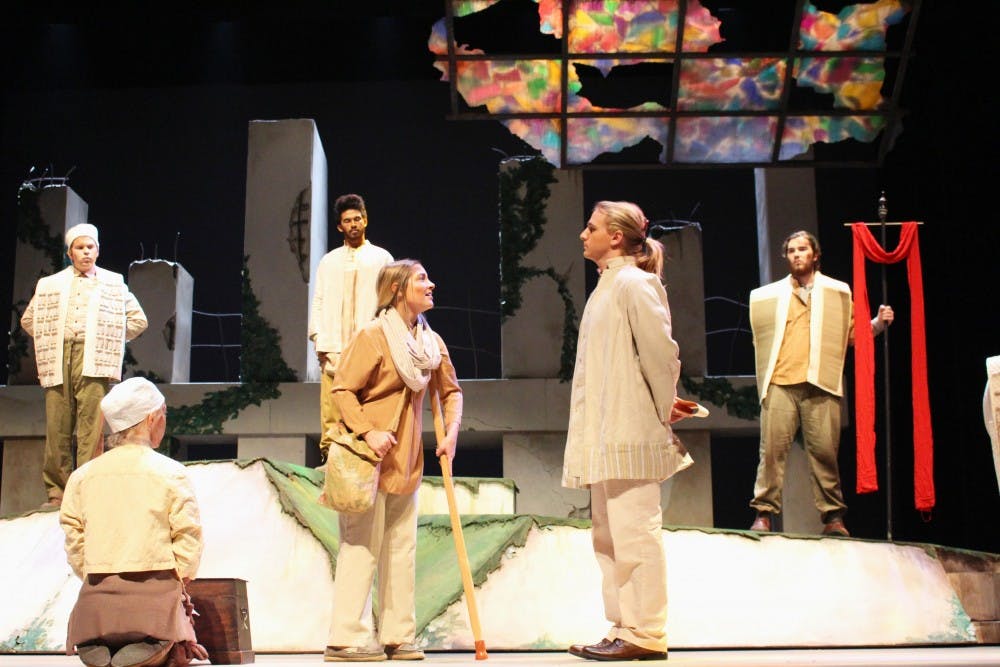The Center for Performing Arts' main stage has created the image of a dystopian society through stone scenery accented with bits of grass and a ripped canvas ceiling.
A group of kids from seven local middle and elementary schools join 17 Miami students in the Theatre Department's upcoming performance of "Gathering Blue."
"We've created a world you can step into and recognize immediately," said Jordan Gravely, senior and assistant stage manager of the show. "It was once this beautiful place and now it's ruined, but there is still something beautiful that exists."
The play, adapted from the book written by Lois Lowry, follows the journey of a young girl, Kira, in a post-apocalyptic society where only the most useful people are allowed to survive.
Born with a crippled leg, Kira is labeled as different and deemed unnecessary. That is until society leaders, the Council of Guardians, discover her weaving talent. Soon after, Kira is given the important job of mending the 'Singer's Robe' -- a special piece of clothing that tells the history of the world -- and is permitted to stay.
"Kira wants to prove to her village that even though she has a disability, that doesn't mean she isn't capable of fulfilling her potential," said sophomore Annie Mallamaci, who plays Kira. "It really says something about how in our daily lives we each have our strengths and talents, and we need to use the strengths we've been given and use them to make society a better place."
"Gathering Blue" is a complex story with multiple layers and dynamics occurring on the same stage, often within the same scene.
"I think a lot of [the cast dynamic] comes from ideas we have about the characters and their relationships with other characters," said junior Nate Bissinger, who plays Jamison. "Since the show isn't that long, the spaces between scenes where characters have had interactions that the audience cannot see creates the greater story."
The play is intense, which can present challenges since the cast is partially comprised of elementary and middle school students.
"There's some censorship so the kids understand," said sophomore ensemble member Molly Boozell. "They haven't really seen the brutality of the world yet. In this show, they have to play kids who have experienced this brutality and see what it's like to suffer: This is a dangerous world."
The children in the cast add an energy that couldn't be replicated by college actors playing younger characters. The little ones do cartwheels, chase each other around and giggle the way only a kid can.
Assistant student director, junior Maddie Mitchell, talked about how she watches scenes and finds a way to make them better.
"When I'm taking notes during rehearsals I'm looking mostly for authenticity," Mitchell said. Are the actors being real? Are they being true? Are they being real people? What I want is for them to be genuine, and to tell the story in the most truthful way they can. It's in the little moments."
While Mitchell takes notes, actors rehearse scenes and are occasionally stopped by Rosalyn Erat Benson, the show's director, who corrects little details like the pronunciation or tone of a particular word, the delivery time of a line or where a certain prop should be placed.
In scenes where only one or two characters are the focus, the presence of others add depth.
"I try to react to whatever's happening in the scene at the moment as honestly as possible," said Eleanor Alger, a freshman ensemble member. "This ends up involving facial expressions and gestures because it's important to remain engaged in a scene even if you aren't necessarily speaking."
Benson reminds actors, "you're always going somewhere," when entering or exiting the stage, and that their movement should then be both purposeful and in character.
There is a scene when members of the society act aggressively toward Kira, but don't move during their lines. After a couple run-throughs, blocking was changed to incorporate actors moving around Kira, personifying this aggression.
"There is no random choice that is made, which goes with the show nicely," Boozell said. "There's such a feeling of cause and effect. Even in the background, tiny little nuances show such vast differences between the people and the community of people, how they fit together and how they're different."
The play is full of symbolism and metaphors carefully illustrated through the script, actors' body language and the set itself.
"Obviously blue is a huge metaphor," Mitchell said. "Kira even has a line that says 'blue is the color of freedom.' These people are so sheltered and shielded from the good in the world, and it's through Kira's journey that the characters are exposed to what could be."
A complicated story with lots of perspectives, "Gathering Blue" evokes important messages of creativity, acceptance and awareness, contrasted by its dystopian setting.
"In real life, there is so much going on in the world and with how people are treating each other disrespectfully...we see it in the news all the time," Mitchell said. "Shakespeare once said that theatre's duty is to hold up a mirror to society. That's exactly what this play does."
"Gathering Blue" performances are at 7:30 p.m. on Nov. 15-16, 10:30 a.m. on Nov. 17 and 2 p.m. on Nov. 18-19 in the Gates-Abegglen Theatre. Tickets can be purchased through the Theatre Department's website.
dattilec@miamioh.edu

